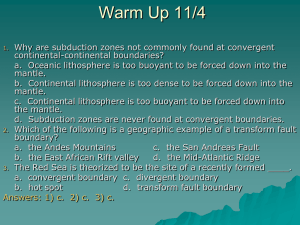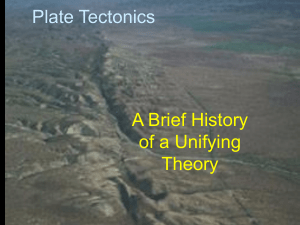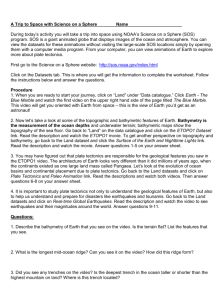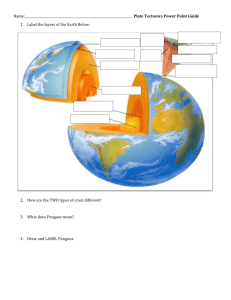9.4 Testing Plate Tectonics Reading and Qs
advertisement
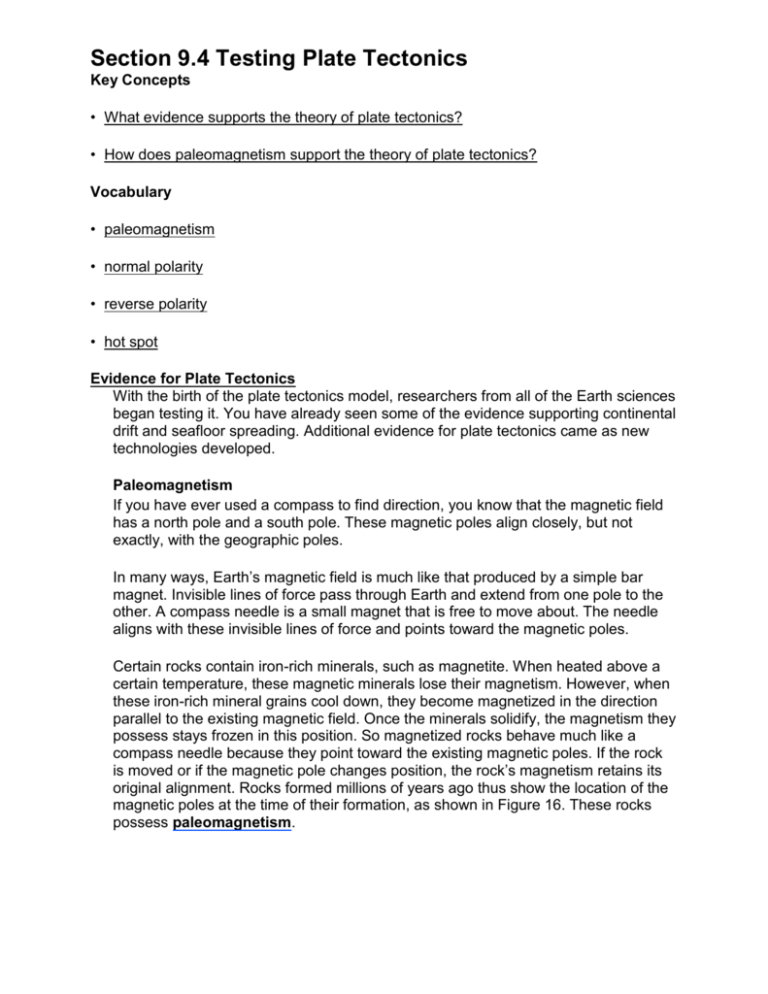
Section 9.4 Testing Plate Tectonics Key Concepts • What evidence supports the theory of plate tectonics? • How does paleomagnetism support the theory of plate tectonics? Vocabulary • paleomagnetism • normal polarity • reverse polarity • hot spot Evidence for Plate Tectonics With the birth of the plate tectonics model, researchers from all of the Earth sciences began testing it. You have already seen some of the evidence supporting continental drift and seafloor spreading. Additional evidence for plate tectonics came as new technologies developed. Paleomagnetism If you have ever used a compass to find direction, you know that the magnetic field has a north pole and a south pole. These magnetic poles align closely, but not exactly, with the geographic poles. In many ways, Earth’s magnetic field is much like that produced by a simple bar magnet. Invisible lines of force pass through Earth and extend from one pole to the other. A compass needle is a small magnet that is free to move about. The needle aligns with these invisible lines of force and points toward the magnetic poles. Certain rocks contain iron-rich minerals, such as magnetite. When heated above a certain temperature, these magnetic minerals lose their magnetism. However, when these iron-rich mineral grains cool down, they become magnetized in the direction parallel to the existing magnetic field. Once the minerals solidify, the magnetism they possess stays frozen in this position. So magnetized rocks behave much like a compass needle because they point toward the existing magnetic poles. If the rock is moved or if the magnetic pole changes position, the rock’s magnetism retains its original alignment. Rocks formed millions of years ago thus show the location of the magnetic poles at the time of their formation, as shown in Figure 16. These rocks possess paleomagnetism. Figure 16 Paleomagnetism Preserved in Lava Flows As the lava cools, it becomes magnetized parallel to the magnetic field present at that time. When the polarity randomly reverses, a record of the paleomagnetism is preserved in the sequence of lava flows. Geophysicists learned that Earth’s magnetic field periodically reverses polarity. The north magnetic pole becomes the south magnetic pole, and vice versa. A rock solidifying during one of the periods of reverse polarity will be magnetized with the polarity opposite that of rocks being formed today. When rocks show the same magnetism as the present magnetic field, they are described as having normal polarity. Rocks that show the opposite magnetism are said to have reverse polarity. A relationship was discovered between the magnetic reversals and the seafloor-spreading hypothesis. Ships towed instruments called magnetometers across segments of the ocean floor. This research revealed alternating strips of high- and low-intensity magnetism that ran parallel to the ridges. The strips of high-intensity magnetism are regions where the paleomagnetism of the ocean crust is of the normal type. These positively magnetized rocks enhance the existing magnetic field. The low-intensity strips represent regions where the ocean crust is polarized in the reverse direction and, therefore, weaken the existing magnetic field. As new basalt is added to the ocean floor at the oceanic ridges, it becomes magnetized according to the existing magnetic field, as shown in Figure 17. The discovery of strips of alternating polarity, which lie as mirror images across the ocean ridges, is among the strongest evidence of seafloor spreading. Figure 17 A As new material is added to the ocean floor at the oceanic ridges, it is magnetized according to Earth’s existing magnetic field. B This process records each reversal of Earth’s magnetic field. C Because new rock is added in approximately equal amounts to the trailing edges of both plates, strips of equal size and polarity parallel both sides of the ocean ridges. Applying Concepts Why are the magnetized strips about equal width on either side of the ridge? Earthquake Patterns Scientists found a close link between deep-focus earthquakes and ocean trenches. Also, the absence of deep-focus earthquakes along the oceanic ridge system was shown to be consistent with the new theory. Compare the distribution of earthquakes shown in Chapter 8 on page 226 with the map of plate boundaries on pages 256–257. The close link between plate boundaries and earthquakes is obvious. When the depths of earthquake foci and their locations within the trench systems are plotted, a pattern emerges. Look at Figure 18. It shows the distribution of earthquakes near the Japan trench. Here, most shallow-focus earthquakes occur within or adjacent to the trench. Intermediate- and deep-focus earthquakes occur toward the mainland. Figure 18 Distribution of Earthquake Foci Note that intermediate- and deepfocus earthquakes occur only within the sinking slab of oceanic lithosphere. In the plate tectonics model, deep-ocean trenches are produced where cool, dense slabs of oceanic lithosphere plunge into the mantle. Shallow-focus earthquakes are produced as the descending plate interacts with the lithosphere above it. As the slab descends farther into the mantle, deeper-focus earthquakes are produced. No earthquakes have been recorded below 700 kilometers. At this depth, the slab has been heated enough to soften. Ocean Drilling Some of the most convincing evidence confirming the plate tectonics theory has come from drilling directly into ocean-floor sediment. The Deep Sea Drilling Project from 1968 to 1983 used the drilling ship Glomar Challenger to drill hundreds of meters into the sediments and underlying crust. When the oldest sediment from each drill site was plotted against its distance from the ridge crest, it was revealed that the age of the sediment increased with increasing distance from the ridge. The data on the ages of seafloor sediment confirmed what the seafloor-spreading hypothesis predicted. The youngest oceanic crust is at the ridge crest and the oldest oceanic crust is at the continental margins. The data also reinforced the idea that the ocean basins are geologically young. No sediment older than 180 million years was found. By comparison, some continental crust has been dated at 4.0 billion years. Hot Spots Mapping of seafloor volcanoes in the Pacific revealed a chain of volcanic structures extending from the Hawaiian Islands to Midway Island and then north to the Aleutian trench, as shown in Figure 19. Dates of volcanoes in this chain showed that the volcanoes increase in age with increasing distance from Hawaii. Suiko Seamount is 65 million years old. Midway Island is 27 million years old. The island of Hawaii formed less than a million years ago and still forming today. Figure 19 Hot Spot The chain of islands and seamounts that extends from Hawaii to the Aleutian trench results from the movement of the Pacific plate over a stationary hot spot. Predicting Where will a new Hawaiian island be located? A rising plume of mantle material is located below the island of Hawaii. Melting of this hot rock as it nears the surface creates a volcanic area, or hot spot. As the Pacific plate moves over the hot spot, successive volcanic mountains have been created. The age of each volcano indicates the time when it was situated over the hot spot. Kauai is the oldest of the large islands in the Hawaiian chain. Its volcanoes are extinct. The youthful island of Hawaii has two active volcanoes—Mauna Loa and Kilauea. Hot spot evidence supports the idea that the plates move over Earth’s surface. SECTION 9.4 Assessment Answer all questions on lined paper and in complete sentences. Reviewing Concepts (1)List and describe the evidence for the plate tectonics theory. (2)Define the term paleomagnetism. (3)What is the age of the oldest ocean crust? How do the ages of the ocean crust compare to the age of continental rocks? (4)What is a hot spot? Critical Thinking (5) Applying Concepts How do hot spots and the plate tectonics theory account for the different ages of the Hawaiian Islands? (6) Predicting Would earthquakes occur at depths of over 700 kilometers? Why or why not?
